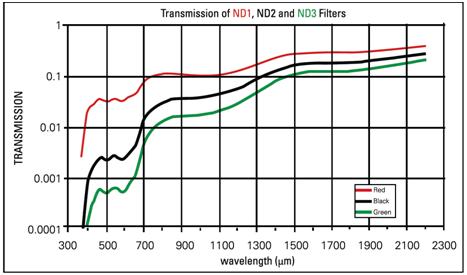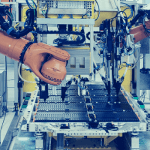Short answer: A neutral density attenuator.
Meaning?
Long(er) answer: A filter that attenuates all wavelengths equally. Well, that’s an ideal ND filter, anyway. A real one affects different wavelength differently, but the difference is kept to a minimum.
In any case, for our purposes an ND filter is your CCD laser beam profiler’s first line of defense.
Laser Beam Profiler with Two ND Filters Installed
If your laser power is too high for the CCD (meaning it’s more than a couple of μW/cm2. Yeah, CCDs are very sensitive), ND filters are the most basic solution. In fact, they are so commonly used that Ophir sends three with all its camera profilers.
But we’re getting ahead of ourselves.
Stackable ND Filters (Different colors are different ND values)
ND filter – the basics:
The first question I ask myself when looking at any attenuating device is, “Where does the laser beam energy all go?”
There are generally up to three answers: reflected, absorbed, transmitted.
For ND filters, there is little or no reflection, so most of the laser is absorbed and some of it is transmitted – as an attenuated form of the original beam.
How much does an ND filter attenuate?
Here’s the formula for NDx (e.g., ND1, ND2, etc.):
where x is the ND value, Iin is the intensity input to the filter, and Iout is the attenuated laser intensity.
But this chart of the common ND values should save you some time:
| ND |
% Transmitted |
% Attenuated |
| 0.3 |
50.00% |
50.00% |
| 0.7 |
20.00% |
80.00% |
| 1 (red) |
10.00% |
90.00% |
| 2 (black) |
1.00% |
99.00% |
| 3 (green) |
0.10% |
99.90% |
| 4 |
0.01% |
99.99% |
Bear in mind that these values do vary somewhat over different wavelengths, so you might find these graphs useful:
Graph of ND Filter Transmission by Wavelength
(These particular ND filters are clearly not intended for UV lasers. Ophir has a separate set of filters designed for those wavelengths.)
Filter Damage Threshold
So, hopefully the filter can stand more laser power than the CCD itself, but does it also have a limit?
Of course. Everything does, you know.
Ophir’s ND filters can withstand laser intensities up to 50 W/cm2. However, we do not recommend using it above 5 W/cm2 to avoid thermal lensing, where the heat is sufficient to distort the filter, turning it into a lens.
Assuming you don’t want thermal lensing (which you don’t), you can’t use these filters if your laser beam power density is above 5 W/cm2. Or can you?
What if you do have a very high power density laser? You’ll probably either need to use a beam splitter or a beam expander to lower the power density before it gets to the filters. But you will likely want to use ND filters, too. Stay tuned for a post on these other attenuators.
You might also like to read:















Comments